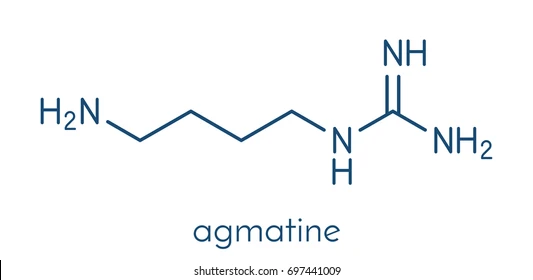Agmatine Sulfate has been on the rise as a popular supplement for a host of reasons in last few years.
In this article, we’ll be talking specifically about its role as a typical bodybuilding supplement. In other words, agmatine’s role if your goal is to improve your physique, build muscle, burn fat, and boost your performance.
What is Agmatine?
Agmatine is a metabolite of the amino acid arginine. “Metabolite” is a fancy way of saying you start with arginine, some chemistry happens, and you end up agmatine.
They’re like cousins.
It’s a related supplement, with a lot of similar benefits (like improving your muscle pumps) which we’ll talk about later on, but it also has a lot of distinct effects and benefits.

It’s science.
Why Agmatine Sulfate?
This is the simplest form of agmatine, and the most popular, stable chemical form that you’ll find on the market. For our purposes, “agmatine” and “agmatine sulfate” are synonymous, because when you buy it in supplement form, this is what you’ll be getting.
Again, chemistry.
What Does Agmatine Do?
Most of agmatine’s benefits stem from its role as a “nitric oxide booster.” That’s a popular marketing term to say agmatine increases our levels of nitric oxide, which subsequently increases blood flow.
Increasing blood flow, in turn, has lots of different benefits.
More Muscle Pumps
The most obvious of the consequences of increased nitric oxide production and blood flow is more muscle pumps. “The pump” in bodybuilding refers to the sensation of your muscles filling up with blood during exercise, which has lots of downstream benefits for performance, muscle building, and recovery.
Blood is our body’s way of sending resources around our body, which during exercise means sending it to the working muscles.
This is exactly why arginine, its cousin, is a popular bodybuilding supplement, and its more distant but still related cousin, citrulline (like the kind of cousin you only see once every few years.)
As for which of these pump supplements are more effective, we will cover this in an upcoming article on agmatine vs arginine vs citrulline.

Look at those veins. Could be because of agmatine.
Cognitive Benefits
Also related to its impact on blood flow, some studies suggest that agmatine can help protect the brain from damage caused by a stroke.
More blood flow means more blood flow to the brain as well, which explains agmatine’s popularity as a “nootropic” ingredient.
However, this benefit is not as pertinent to its role for bodybuilding and performance.
Erectile Dysfunction
While also not related to bodybuilding or performance, sexual performance is a big reason why a lot of people train, whether they want to admit it or not. Because of its blood flow benefits, agmatine may be a non-pharmaceutical solution to help get your guy up.
Pain Relief Agent
The big difference in effects between agmatine and its amino acid cousins is its role in relieving pain. And the research in this area is fairly substantial.
One study showed that it decreased lower back pain and another showed overall decreased pain sensitivity in mice.
This makes agmatine sulfate a popular pre-workout ingredient for those dealing with nagging injuries.
In fact, in some products, agmatine is advertised for joint health. While it doesn’t actually improve the health of your joints, it will reduce the temporary pain.
This is putting a band-aid on what are probably deeper underlying problems causing pain. But for bodybuilders in contest prep, for example, a simple supplement that can make your joints feel better while you train can be a huge boost.
Regulating Blood Sugar, Insulin Response
This benefit has the least amount of substantial research, but it’s still worth noting because its potential benefits for physique is its effects on insulin sensitivity and blood sugar regulation.
Managing blood sugar effectively is one of the keys to overall longevity, as we discussed in this article on nutrition for longevity.
It’s also a crucial component of fat loss, which obviously has physique and performance benefits.
Some mice studies have suggested an increase in insulin sensitivity, although more research is needed.
Should You Take Agmatine Sulfate?
If blood flow is your only goal, then as we’ll discuss in the upcoming article, we think other supplements like arginine and citrulline make more sense.
However, if you’re going for both blood flow and pain relief, then agmatine sulfate is an excellent supplement option that can cover both. And it’s inexpensive.
Side Effects
Agmatine users have reported gastrointestinal distress. So if you gut health issues, it may make more sense to look for other pump-inducing supplement options.
When Should You Take Agmatine Sulfate?
Because its two main benefits are to manage pain and enhance blood flow, it makes the most sense to take it pre-workout. In fact, you’ll find it in many pre-workouts, but you can also use pure agmatine sulfate powder and add it to any pre-workout drink.
How Much Agmatine Should You Take?
In supplements, the doses typically range from 250mg to 1g. Because it’s been proven safe, if you’re going to take agmatine, it makes sense to start with a gram.
Lots of users have reported success with up to 2 grams.
Where to Buy Agmatine Sulfate
Lots of popular supplement companies have it. For example, Bulk Supplements sells agmatine in bulk for cheap. They’re a third-party-tested and reputable brand. And you get a simple, pure powder that’s easy to add to any pre-workout supplement stack.
Can I Get Agmatine From Food?
While the technical answer to this is yes, the practical answer is no. Wine, beer, bread, and more foods have trace amounts of agmatine, but not enough to have any substantial difference. And we definitely don’t suggest you start drinking beer pre-workout.
So if you want the effects of agmatine, then supplementing is the only realistic option.
How Does Agmatine Work?
As we’ve talked about, agmatine plays a key role in nitric oxide production. More specifically, though, the mechanism behind this is that it delays the production of an enzyme called nitric oxide synthase.

2 Pingbacks